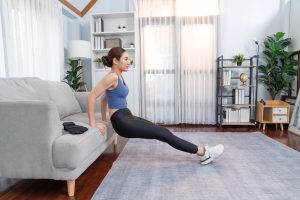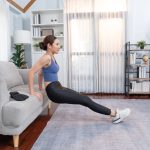1. Understanding the Home Workout
A home workout is a structured fitness routine performed without the need for a gym, using body weight, resistance bands, dumbbells, or household items. The rise of the home workout trend has been fueled by convenience, privacy, and flexibility—allowing individuals to exercise whenever motivation strikes. From yoga and HIIT to circuit training and calisthenics, this approach empowers people to stay active regardless of their environment or schedule.
The foundation of a successful home workout lies in balancing cardio, strength, flexibility, and recovery. Whether you’re targeting endurance or toning specific muscle groups, these routines can be as effective as traditional gym sessions with proper technique and progression.
2. Why Beginners Should Start With Home Workout
Beginners often find the home workout approach less intimidating. There’s no pressure from others, and no commute or membership fees—just you and your goals. Starting small, such as with 15-minute daily sessions, helps build momentum and establish consistency.
Moreover, training at home eliminates common barriers like crowded spaces or lack of confidence. This self-paced method encourages mindfulness and builds discipline—traits essential for long-term health.
3. Perfecting Your Home Workout Form
Form determines results and safety during any home workout. Incorrect posture can lead to strains or slow progress. Always maintain core engagement, neutral spine alignment, and controlled breathing during each movement.
Filming yourself or using mirrors can help identify form errors. Pay attention to proper alignment during squats, planks, or push-ups. Over time, correct technique enhances muscle activation and reduces injury risk—making each session more efficient.
4. Common Mistakes and How to Fix Them
Many people make predictable mistakes: overtraining, skipping warm-ups, or neglecting recovery. Skipping rest days can lead to fatigue and plateauing. Instead, schedule at least one active recovery day weekly.
Another mistake is doing repetitive movements without progression. Gradually increase reps, weights, or resistance to maintain challenge. Lastly, avoid neglecting nutrition—every training program benefits from balanced fueling before and after exercise.
5. Home Workout Name Variations and Similar Exercises
Alternative terms for home workout include at-home fitness routine, bodyweight training, home fitness circuit, domestic workout, and indoor exercise session.
Similar routines include:
-
Calisthenics: Bodyweight exercises like push-ups, pull-ups, and squats.
-
Yoga: Combines flexibility, balance, and breathing control.
-
Pilates: Focuses on core strength and body awareness.
-
Resistance band training: Portable strength sessions for all fitness levels.
6. Home Workout Variations to Keep It Fresh
To prevent boredom, rotate different formats weekly. Examples include:
-
HIIT (High-Intensity Interval Training): Short bursts of intense effort followed by rest.
-
Circuit Training: Combines cardio and strength in timed rounds.
-
Tabata: 20 seconds of maximum effort followed by 10 seconds of rest.
-
Yoga Fusion: Blends flexibility, stability, and strength movements.
By mixing formats, your sessions remain engaging and promote full-body development.
7. Benefits Beyond the Main Focus
Training at home offers more than just physical improvements. It enhances mental clarity, stress management, and emotional balance. Regular activity releases endorphins, boosting mood and confidence.
Economically, this method saves money on memberships and travel. Environmentally, it reduces commuting-related emissions. Consistency in practice contributes to longevity and better quality of life—reinforcing the holistic value of staying active indoors.
8. How to Incorporate Home Workout Into Your Routine
The best way to integrate a home workout into your daily life is through habit stacking—linking it to existing routines. For instance, start your session right after morning coffee or during a lunch break.
Create a dedicated space with minimal distractions. Even small areas can host a workout if properly organized with mats, dumbbells, and resistance bands. Setting specific time slots helps build accountability and routine stability.
9. The Science Behind the Home Workout
Scientific studies confirm that consistent home training improves cardiovascular health, muscular strength, and flexibility comparably to gym-based regimens. Research published in Frontiers in Physiology highlights that home-based resistance and HIIT sessions can significantly enhance endurance and metabolism.
Furthermore, working out at home fosters intrinsic motivation—an essential component for sustained adherence. Behavioral science suggests that people who design personal environments for fitness are far more likely to maintain activity long-term.
10. Tracking Your Progress
Monitoring progress ensures continuous improvement. Use digital tools or fitness apps to log repetitions, durations, and perceived exertion. Tracking visual results through photos or measurements every 30 days can be motivating.
Set SMART goals—Specific, Measurable, Achievable, Relevant, and Time-bound—to stay on target. A home workout evolves as your strength, stamina, and confidence grow. Adjust intensity or add new challenges periodically to sustain momentum.
11. Staying Motivated and Consistent
Consistency fuels success in any home workout journey. Pair music with routines to elevate mood, or follow guided sessions via YouTube. Accountability partners or virtual trainers can also enhance discipline.
When motivation dips, remind yourself of progress milestones and health improvements. Treat home training not as a temporary fix, but as a lifestyle investment that strengthens body and mind alike.
YouTube Video: Full Body Home Workout for Beginners (No Equipment)
Reference
-
Schumann, M., et al. (2021). “Home-based resistance training improves strength, muscle mass, and functional performance.” Frontiers in Physiology.







